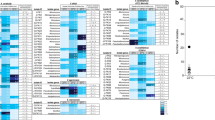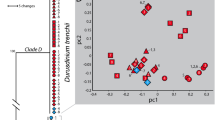Abstract
Laboratory studies on the ecological physiology of a coral pathogen were carried out to investigate growth potential in terms of environmental factors that may control coral diseases on reefs. The disease chosen for this study, white plague type II, is considered to be one of the major diseases of Caribbean scleractinian corals, affecting a wide range of coral hosts and causing rapid and widespread tissue loss. It is caused by a single pathogen, the bacterium Aurantimonas coralicida. A series of laboratory experiments using a pure culture of the pathogen was carried out to examine the roles of temperature, pH, and O2 concentration on growth rate. Results revealed optimal growth between 30 and 35°C, and between pH values of 6 and 8. There was a distinctive synergistic relationship between pH and temperature. Increasing temperature from 25 to 35°C expanded the range of pH tolerance from a minimum of 6.0 down to 5.0. O2 concentration directly affected growth rate, which increased with increasing O2. The combined effects of increasing O2 and increasing temperature resulted in a synergistic effect of more rapid growth. These laboratory results are discussed in terms of the coral host and the range of the environmental factors that occur on coral reefs. We conclude that changing environmental conditions in the reef environment, in particular observed increases in water temperature, may be promoting coral diseases by allowing coral pathogens to expand their ecological niches. In the case of the white plague type II pathogen, elevated temperature would allow A. coralicida to colonize the low pH environment of the coral surface mucopolysaccharide layer as an initial stage of infection. The synergistic effect between temperature and oxygen concentration appeared to be less environmentally relevant for this coral pathogen.




Similar content being viewed by others
References
Alker, AP, Smith, GW, Kim, K (2001) Characterization of Aspergillus sydowii (Thom et Church), a fungal pathogen of Caribbean sea fan corals. Hydrobiol 460: 105–111
Banin, E, Ben-Haim, Y, Israely, T, Loya, Y, Rosenberg, E (2000) Effect of the environment on the bacterial bleaching of corals. Water Air Soil Pollut 123: 337–352
Banin, E, Israely, T, Fine, M, Loya, Y, Rosenberg, E (2001) Role of endosymbiotic zooxanthellae and coral mucus in the adhesion of the coral-bleaching pathogen Vibrio shiloi to its host. FEMS Microbiol Lett 199: 33–37
Banin, E, Khare, SK, Naider, F, Rosenberg, E (2001) Proline-rich peptide from the coral pathogen Vibrio shiloi that inhibits photosynthesis of zooxanthellae. Appl Environ Microbiol 67(4): 1536–1541
Banin, E, Ben-Haim, Y, Fine, M, Israely, T, Rosenberg, E (2002) Virulence mechanisms of the coral bleaching pathogen Vibrio shiloi. Proc 9th Intl Coral Reef Symp 2: 1261–1266
Ben-Haim, Y, Thompson, FL, Thompson, CC, Cnockaert, MC, Hoste, B, Swings, J, Rosenberg, E (2003) Vibrio coralliilyticus sp. nov., a temperature-dependent pathogen of the coral Pocillopora damicornis. Int J Syst Evol Microbiol 53: 309–315
Ben-Haim, Y, Zicherman-Keren, M, Rosenberg, E (2003) Temperature-regulated bleaching and lysis of the coral Pocillopora damicornis by the novel pathogen Vibrio coralliilyticus. Appl Environ Microbiol 53: 309–315
Borger, JL (2003) Three scleractinian coral diseases in Dominica, West Indies: Distribution, infection and contribution to coral tissue mortality. Rev Biol Trop 51(Suppl. 4): 25–38
Brenner, DJ, Kreig, NR, Staley, JT (2005) Bergey's Manual of Systematic Bacteriology, vol. 2 (2nd ed.), Springer, East Lansing, p 304
Cervino, J, Goreau, TJ, Nagelkerken, I, Smith, GW, Hayes, R (2001) Yellow band and dark spot syndromes in Caribbean corals: Distribution, rate of spread, cytology, and effects on abundance and division rate of zooxanthellae. Hydrobiol 460: 53–63
Cervino, J, Hayes, RL, Polson, SW, Goreau, T, Martinez, RJ, Smith, GW (2004) Relationship of Vibrio species infection and elevated temperatures to yellow blotch/band disease in Caribbean corals. Appl Environ Microbiol 70: 6855–6864
Cheng, W, Chen, J (1998) Enterococcus-like infections in Marcrobrachium rosenbergii are exacerbated by high pH and temperature but reduced by low salinity. Dis Aquat Org 34: 103–108
Denner, EBM, Smith, GW, Busse, H-J, Schumann, P, Narzt, T, Polson, SW, Lubitz, W, Richardson, LL (2003) Aurantimonas coralicida gen. nov., sp. nov., the causative agent of white plague type II on Caribbean scleractinian corals. Int J Syst Evol Microbiol 53: 1115–1122
Ducklow, HW, Mitchell, R (1979) Bacterial populations and adaptations in the mucus layers on living corals. Limnol Oceanogr 24: 715–725
Fitt, WK, Brown, BE, Warner, ME, Dunne, RP (2001) Coral bleaching: interpretation of thermal tolerance limits and thermal thresholds in tropical corals. Coral Reefs 20: 51–65
Garzón-Ferreira, J, Gil-Agudelo, DL, Barrios, LM, Zea, S (2001) Stony coral diseases observed in southwestern Caribbean reefs. Hydrobiol 460: 65–69
Gomori, G (1955) Preparation of buffers for use in enzyme studies. In: Methods in Enzymology, Academic Press, New York, pp 138–146
Goreau, TJ, Cervino, J, Goreau, M, Hayes, R, Hayes, M, Richardson, L, Smith, G, DeMeyer, K, Nagelkerken, I, Garzon-Ferrera, J, Gil, D, Garrison, G, Williams, EH, Bunkley-Williams, L, Quirolo, C, Patterson, K, Porter, JW, Porter, K (1998) Rapid spread of diseases in Caribbean coral reefs. Rev Biol Trop 46(Suppl. 5): 157–171
Goreau, TJ, Hayes, RL (1994) Coral bleaching and ocean “hot spots.” Ambio 23: 176–180
Green, EP, Bruckner, AW (2000) The significance of coral disease epizootiology for coral reef conservation. Biol Conserv 96: 347–361
Harvell, CD, Kim, K, Burkholder, JM, Colwell, RR, Epstein, PR, Grimes, DJ, Hofmann, EE, Lipp, EK, Osterhaus, ADME, Overstreet, RM, Porter, JW, Smith, GW, Vasta, GR (1999) Emerging marine diseases—climate links and anthropogenic factors. Science 285: 1505–1509
Hayes, ML, Bonaventura, J, Mitchell, TP, Prospero, JM, Shinn, F, Van Dolah, F, Barber, RT (2001) How are climate and marine biological outbreaks functionally linked? Hydrobiol 460: 213–220
Iglesias-Prieto, R (1997) Temperature-dependent inactivation of photosystem II in symbiotic dinoflagellates. Proc 8th Int Coral Reef Symp, Panama 2: 1313–1318
Jokiel, PL (2004) Temperature stress and coral bleaching. In: Rosenberg, E, Loya, Y (Eds.) Coral Health and Disease, Springer, Berlin, pp 401–419
Jolles, AE, Sullivan, P, Alker, AP, Harvell, CD (2002) Disease transmission of Aspergillosis in sea fans: Inferring process from spatial patterns. Ecology 83(9): 2373–2378
Jones, RJ, Bowyer, J, Hoegh, O, Blackall, LL (2004) Dynamics of a temperature-related coral disease outbreak. Mar Ecol Prog Ser 281: 63–77
Kaczmarsky, L, Draun, M, Williams, E (2005) Is there a relationship between proximity to sewage effluent and the prevalence of coral disease? Caribb J Sci 41: 124–137
Klaus, JS, Frias-Lopez, J, Fouke, BW (2003) The effects of temperature and aquaria conditions on bacterial communities inhabiting healthy tissues of Diploria strigosa. Appl Environ Microbiol 69: 2409–2413
Kuta, KG, Richardson, LL (2002) Ecological aspects of black band disease of corals: relationships between disease incidence and environmental factors. Coral Reefs 21: 393–398
Makemson, JC, Hermosa, GV (1999) Luminous bacteria cultures from fish guts in the Gulf of Oman. Luminescence 14: 161–168
Mayo, AW, Noike, T (1996) Effects of temperature and pH on the growth of the heterotrophic bacteria in waste stabilization ponds. Water Res 30: 447–455
Miller, J, Rogers, C, Waara, R (2003) Monitoring the coral disease, plague type II, on coral reefs in St. John, U.S. Virgin Islands. Rev Biol Trop 51(Suppl. 4): 47–55
Moriarty, D, Pollard, P, Hunt, W (1985) Temporal and spatial variation in bacterial production in the water column over a coral reef. Mar Biol 85: 285–292
Nakayama, S, Watanabe, H (1995) Involvement of cpxA, a sensor of a two component regulatory system, in the pH dependant regulation of expression of Shigella virF gene. J Bacteriol 177: 5062–5069
Nugues, MM (2002) Impact of a coral disease outbreak on coral communities in St. Lucia: What and how much had been lost? Mar Ecol Prog Ser 229: 61–71
Peters, EC (1984) A survey of cellular reactions to environmental stress and disease in Caribbean scleractinian corals. Helgol Meeresunters 37: 133–137
Phillips, JH (1963) Immune mechanisms in the phylum Coelenterata. In: Dougherty, EC, Brown, ZN, Hanson, ED, Hartman, WD (Eds.) The Lower Metazoa: Comparative Biology and Phylogeny. University of California Press, Berkeley, pp 425–431
Pilson, MEQ (1998) An Introduction to the Chemistry of the Sea. In: McConnin, RA (Ed.) Prentice Hall, New Jersey, p 391
Ratkowsky, DA, Olley, J, McMeekin, TA, Ball, A (1982) Relationship between temperature and growth rate of bacterial cultures. J Bacteriol 149: 1–5
Richardson, LL (1998) Coral diseases: What is really known? TREE 13: 438–443
Richardson, LL, Goldberg, WM, Kuta, KG, Aronson, RB, Smith, KB, Ritchie, KB, Halas, JC, Feingold, JS, Miller, SL (1998) Florida's mystery coral-killer identified. Nature 392: 557–558
Richardson, LL, Goldberg, WM, Carlton, RG, Halas, JC (1998) Coral disease outbreak in the Florida Keys: Plague type II. Rev Biol Trop 46(Suppl. 5): 187–198
Richardson, LL, Kuta, KG (2003) Ecological physiology of the black band disease cyanobacterium Phormidium corallyticum. FEMS Microbiol Ecol 43: 287–298
Rosenberg, E (2004) The bacterial disease hypothesis of coral bleaching. In: Rosenberg, E, Loya, Y (Eds.) Coral Health and Disease, Springer, Berlin, pp 445–459
Rosenberg, E, Loya, Y (2004) Coral Health and Disease. Springer-Verlag, Berlin, p 488
Santavy, DL, Peters, EC (1997) Microbial pests: Coral diseases in the western Atlantic. Proc 8th Intl Coral Reef Symp 1: 607–612
Sutherland, KP, Porter, JW, Torres, C (2004) Disease and immunity in Caribbean and Indo-Pacific zooxanthellate corals. Mar Ecol Prog Ser 266: 273–302
Warner, M, Fitt, W, Schmidt, G (1999) Damage to photosystem II in symbiotic dinoflagellates: A determination of coral bleaching. Proc Natl Acad Sci 96: 8007–8012
Weil, E (2004) Coral reef diseases in the wider Caribbean. In: Rosenberg, E, Loya, Y (Eds.) Coral Health and Disease, Springer, Berlin, pp 35–68
Acknowledgments
We thank J. Makemson and C. Bigger for helpful discussions and suggestions and the Florida Keys National Marine Sanctuary for boat support. The comments of an anonymous reviewer greatly improved this manuscript. This article is a result of research funded by the National Oceanic and Atmospheric Administration's National Undersea Research Program administered by the University of North Carolina, Wilmington (award FKRP-2004-11A), and by the National Institutes of Health (NIH/NIGMS SO6GM8205). This is contribution number 99 from the Tropical Biology Program at Florida International University.
Author information
Authors and Affiliations
Corresponding author
Rights and permissions
About this article
Cite this article
Remily, E.R., Richardson, L.L. Ecological Physiology of a Coral Pathogen and the Coral Reef Environment. Microb Ecol 51, 345–352 (2006). https://doi.org/10.1007/s00248-006-9029-9
Received:
Accepted:
Published:
Issue Date:
DOI: https://doi.org/10.1007/s00248-006-9029-9




